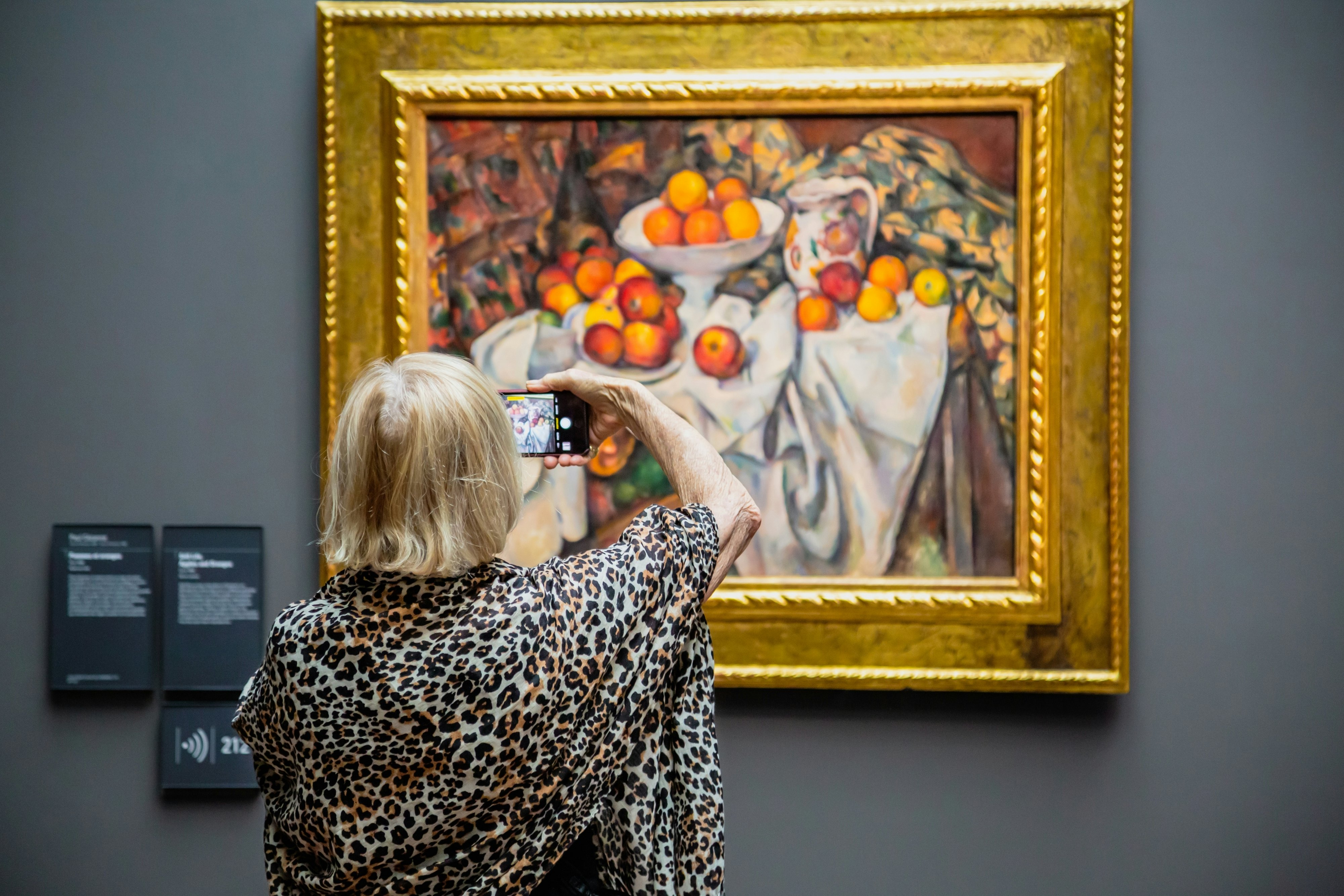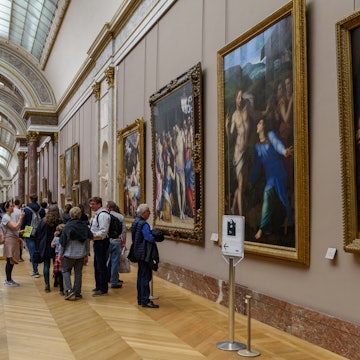

The Musée d'Orsay is one of Paris’ top sights. Here’s how to best enjoy it. Pyty/Shutterstock
Paris’ Rive Gauche (Left Bank) is the historic stomping ground of artists, tastemakers and cultural icons. To this day, the neighborhood remains an artistic hub, home to the École des Beaux-Arts and a number of art galleries – including the Musée d'Orsay, the second-most-visited art museum in Paris, after the Louvre.
Home to France’s national collection of works from the impressionist, post-impressionist and art nouveau movements (1848 to 1914), the Musée d’Orsay is housed in the glorious former Gare d’Orsay train station (itself an art nouveau showpiece). Here, you’ll find a roll call of masters, with world-renowned works by Édouard Manet, Claude Monet, Paul Cézanne, Pierre-Auguste Renoir, Edgar Degas, Camille Pissarro, Vincent van Gogh and many more on glorious display.
To make the most of you visit to this popular museum, we’ve put together a guide of what you need to know before you go – and once you get there.
When should I go to the Musée d’Orsay?
As you might expect, crowds are smaller at the Musée d’Orsay in winter, between November and March. From spring until autumn (April to October), you can expect the museum to be busy, yet there are a number of measures designed to manage high visitor numbers.
According to our local sources, the museum is busier on Tuesdays and Sundays, and that the best time to visit is around the middle of the day, when crowds thin out for a proper lunch break, as the French do.
The Musée d’Orsay is closed on Mondays. On Thursdays, the galleries stay open late, with ticket slots starting at 6pm. The last entry is at 9pm, and the museum closes at 9:45pm.
As well as the extraordinary permanent collection, visitors can enjoy temporary exhibitions, small concerts, film screenings, performances and cafe readings. Check the museum’s website to time your visit to one of these special events.

A warning about purchasing tickets for the Musée d’Orsay
You will save time by pre-purchasing tickets online and heading to the right queue. If you have a specific time slot, head to queue A2. If you have pre-purchased tickets but without a time slot head to entrance C, queue 1.
If you don’t have a ticket and just want to wing it on the day, you’ll be joining queue C2.
To save some euros, it is possible to get a ticket combined with entrance to the Musée de l’Orangerie, and to the Musée Rodin. The Musée d’Orsay is also free on the first Sunday of the month – but you must book ahead for a specific time slot online.
It’s also important to note there has been a proliferation of fake Musée d’Orsay ticket sites. So be sure to buy your tickets from the official site (linked above).
How much time should I spend at the Musée d’Orsay?
It’s almost impossible to view the entire collection in one day. Instead, we’d advise picking one or two areas of interest and use these to direct your exploration. For a fee, audioguides provide commentary from the museum’s curators on over 300 works.
You can also pay to join one of the museum’s themed guided tours. Held daily in English, French and Italian, the 1½-hour tours follow themes such as ”masterpieces,“ ”animals“ and ”parties”; check the museum’s website for departure times. At busy times, book your tour slot in advance and allow plenty of time to get into the museum to meet up with the group.
Pre-plan your itinerary in the museum by consulting the online visitor online.
Admire the architecture of the Musée d’Orsay
As you enter the Musée d’Orsay, you’ll immediately notice the layout of the ground floor, with sculptures in two straight rows, and small galleries lining the outer edges of the space.
This museum layout evokes the original railway station. Indeed, when authorities set out to transform the building into a museum, they made the decision to elevate the history of architecture to the status of the history of art, given the sheer significance of the encasing building. Accordingly, architectural drawings by the likes of Gustave Eiffel and Viollet-le-Duc hang alongside works by famous artists.
At the end of the ground floor is a space dedicated to the history of Paris’ urban development. Look below you and you’ll notice an intricate scale model of the city as it stood in 1914.

Explore the many masterpieces at the Musée d’Orsay
Most people visit the Musée d’Orsay for its outstanding collection of impressionist works, with the 5th floor of the museum largely dedicated to the movement. By tracing the galleries in a clockwise direction you’ll get a fairly comprehensive overview of the development of the movement and its successors, from impressionism to post-impressionism to neo-impressionism. Here is where the well-known masterpieces such as Monet’s Londres, le Parlement, Van Gogh’s Starry Night over the Rhône, and Degas’ sculpture La Petite Danseuse de Quatorze Ans are exhibited alongside other fabled modern works, including several of Cézanne’s glorious still lifes.
Learn more about French cinema
Few know that from its start the Musée d’Orsay has emphasized the history of cinema and cinematography – innovating an approach that considers film an art rather than a mere technique or entertainment. On the 5th floor, tucked away alongside the impressionist collection, is a gallery tracing the medium’s history and technical developments, with projections of short clips from pivotal films in the medium’s history. To complement this venture, the Musée d’Orsay often holds screenings in its auditorium of some of the most important works of cinema from the early 20th century. Check the official website for a schedule.
Compare contemporary and historic art
Although the focus of the Musée d’Orsay is art from the period between 1848 and 1914, several times a year the museum invites major players on the contemporary art scene – past participants have included Jean-Philippe Delhomme, Marlene Dumas and Peter Doig – to curate exhibitions featuring their own works juxtaposed with selections from the permanent collection.
By placing contemporary art in direct dialogue with historical masterpieces, these displays help viewers consider the works with a fresh perspective while emphasizing their enduring importance. On one Thursday evening per month, the museum also hosts “Curious Thursdays,” when young artists from other creative worlds (like dance and music) are invited to perform among the artworks.
Don’t miss these masterpieces at the Musée d'Orsay
Éduoard Manet’s Le Déjeuner sur l’herbe
Vincent Van Gogh’s Starry Night Over the Rhône
Edgar Degas’ La Petite Danseuse de Quatorze Ans
Claude Monet’s Londres, le Parlement
Auguste Renoir’s Bal du Moulin de la Galette
Paul Cézanne's Apples and Oranges
Gustave Courbet’s L’Origine du Monde
Inspired? Pick up your own art supplies at Magasin Sennelier
Feeling inspired? While you’re in the neighborhood, the nearby Magasin Sennelier on quai Voltaire is a famous art-supply store that dates back to 1887. Passionate about the chemistry of colors, Gustave Sennelier developed his own range of oil paints using pigments and binders sourced from his European travels. Artists such as Cézanne and Gauguin worked directly with Sennelier to create custom colors; later, the shop innovated with oil pastels for Pablo Picasso. To this day, the maison is a rendezvous point for artists who consider Sennelier to be la crème de la crème.

Where can I eat or drink at the Musée d'Orsay?
You’ll find a host of dining options at the museum. Its restaurant, simply called “The Restaurant,” offers a seasonal menu to diners in a stunning gilded salon. Grab a bite or a cup of tea in Café Campana: the dining room has as its centerpiece the large clock visible at the top of the building.
You can also get lighter bites at one of two cafes, and a kiosk (Le Kiosque du Parvis) that sells sandwiches, falafel and light refreshments. Break up your visit with a pause in the museum’s gilded tearoom, which was formerly the railway station’s dining room.
Beyond the museum, head to the arcade Beaupassage, where multiple refuellng options range from Pierre Hermé’s tearoom-like cafe to the hipster coffee spot % Arabica in the courtyard and Thierry Marx’ bakery.
If you want to take your Musée d’Orsay experience to a luxe level, you could combine it with an evening at what many call the world’s best restaurant, Restaurant Guy Savoy. A temple to gastronomy, this culinary destination is ensconced in the neoclassical Monnaie de Paris and begins with a red-carpeted staircase. Need we say more?
Is the Musée d’Orsay child-friendly?
As well as offering free admission to under-18s, the Musée d’Orsay also offers kid-friendly audioguide options (aimed at the under-12s) and family-friendly self-guided tours.
Large strollers need to be checked at the cloakroom, but museum-appropriate strollers are on offer so your little ones don’t have to traipse around for hours.

What is the best way to get to the Musée d’Orsay?
The museum is near the metro station Solférino on line 12; several buses also stop nearby. If you’re coming via RER, take line C to the Musée d'Orsay station, directly below the galleries. There’s also a Batobus stop outside, if arriving by riverboat is your preferred transport option. As everywhere in Paris, you can walk or cycle for the most sustainable way to get around town.
Is the Musée d’Orsay accessible?
Yes. All of the museum’s galleries are accessible by wheelchair; there are adapted toilets, access ramps, automatic doors and elevators, too. People with disabilities and one accompanying visitor are also given free admission to the museum. If you have mobility concerns, you can also borrow a wheelchair or a folded seat to make your visit more comfortable.
This article was adapted from Lonely Planet’s Paris guidebook, published in March 2024.
















